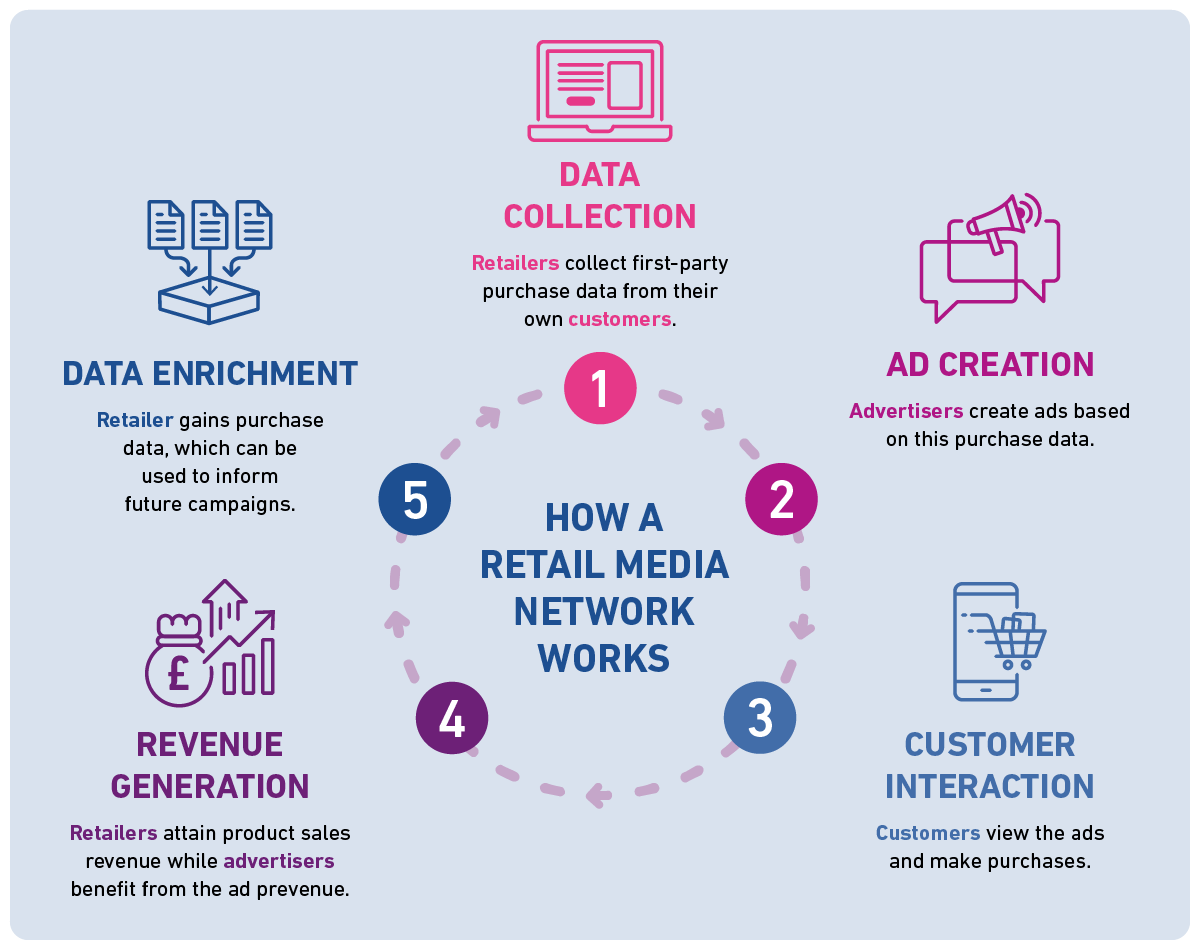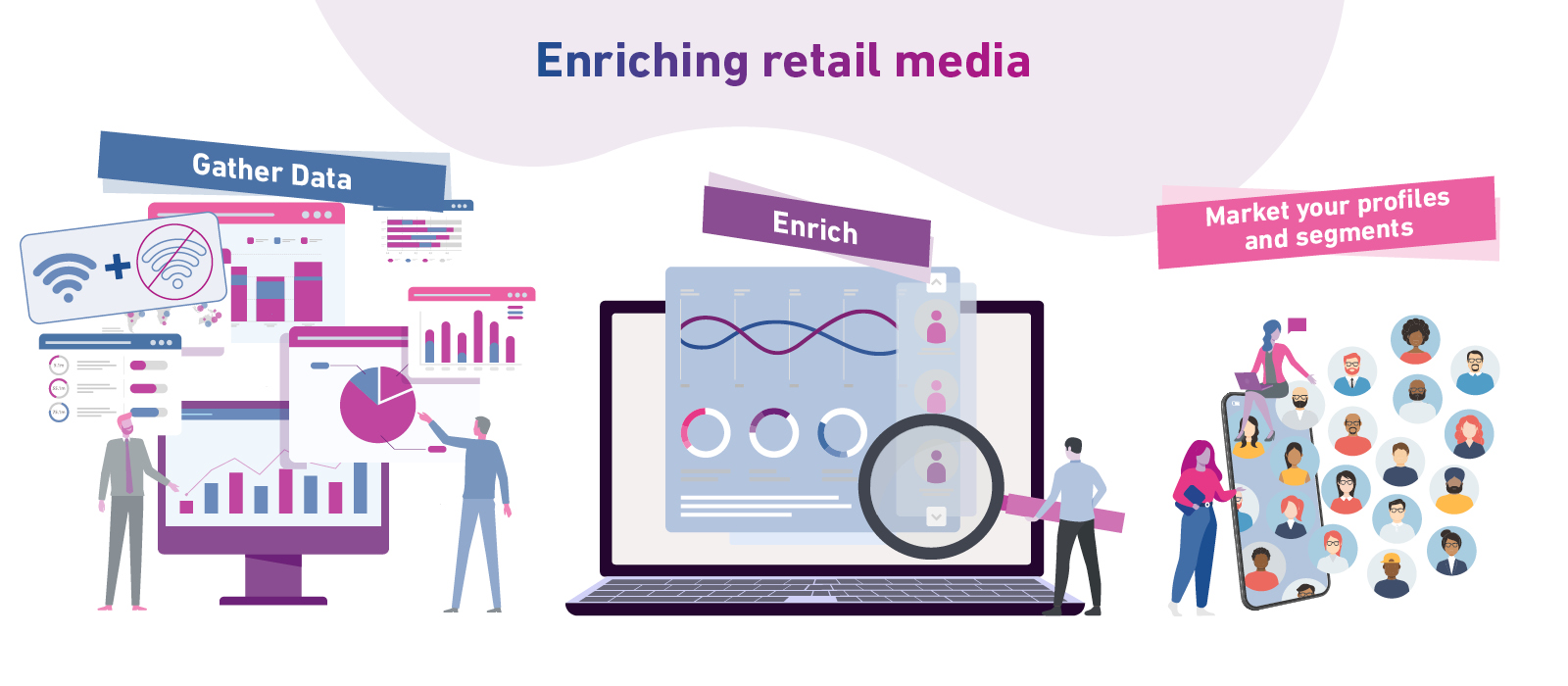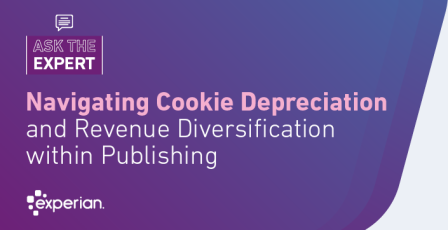Retail media is rapidly transforming the advertising landscape by enabling retailers to leverage their own data as an additional revenue stream, providing advertisers rich datasets in a world where 3rd party cookies are in decline. With major players like Amazon dominating the retail media network (RMN) market, retailers of all sizes can capitalise on their own high-value first-party data and explore the broader potential of commerce media.
What is retail media and commerce media?
Retail media is a form of advertising where retailers use their own digital and physical properties, such as websites, apps, and in-store displays, to promote products and services, either from their own inventory or from external brands. It uses the retailer’s access to consumer purchasing and behaviour data to deliver highly-targeted and relevant ads.
Commerce media is the use of first-party data from a more broad ecosystem of retailers, marketplaces, platforms and sources to create personalised and highly-targeted ad campaigns delivered across a range of digital channels, including social media, search engines and video platforms.

The current landscape of retail media
Retail media offers retailers an additional revenue stream by providing media inventory that not only uses first-party data but also places ads at a point in a user’s purchasing journey.
That media inventory could be in-store placement (a strength for large retailers), Out of Home (OOH) advertising placements, or purely digital placements – a growing market as more organisations grow their online channels.
For example, if a business sells leather sofas online, it can target people on a retailer website like Amazon who are searching for ‘leather sofas’ or other relevant terms. If shoppers are in the bread aisle of a supermarket, they may see a display ad nearby for butter. This offers advertisers data-led, Bottom-of-funnel (BOFU) targeting—an incredibly appealing proposition.
This use of first-party data and BOFU targeting also makes retail media ads incredibly personalised; ads relevant to a consumer’s interests and aligned with their behaviours make shoppers more likely to engage with a brand. This is not only a benefit for advertisers, but is a big advantage for consumers—research has shown that approximately 50% of consumers[1] will spend more money with companies that personalise their e-commerce retail experience.
One of the key factors to this space is that retailer giants like Amazon almost monopolise the potential income from this revenue stream – Amazon captured 78% of digital retail media ad spend in 2023[2], that’s nearly £4 of every £5 spent. And in the UK, several major retailers have strong retail media networks including established giants like Tesco, Sainsbury’s and Boots, as well as more recent entrants such as Deliveroo and Uber. Against the vast customer base and rich first-party data of these giants, smaller RMNs need to communicate their unique appeal to advertisers. Namely, first-party data tends to be more niche, which can offer great opportunities when enriched with external data. This supports wider audience definitions for advertisers to buy against and opens up non-endemic options.
Key takeaway
If you are a retailer and focus predominantly on retail media as an additional revenue stream purely through ads, you’re missing out by not exploring the wider opportunity offered by data enrichment and commerce media.
The wealth of first-party data held by RMNs of all sizes gives them incredible leverage with advertisers actively seeking solutions to the scrutiny and decline of third-party cookies. The demand for rich, compliant data is high.
Retail media vs. commerce media: unlocking potential beyond ad revenue
Retail media focuses on displaying ads on a retailer’s own platforms, but commerce media represents a broader ecosystem – it’s about how retailers derive the most value from their first-party data by helping advertisers engage with their audiences.
The opportunity is no longer in allowing advertisers to leverage insights in your own channels, but to extend the use of these insights to find those target audiences off-site. And this isn’t limited solely to retailers and RMNs either – this is an option to any business collecting first-party data, for example service providers like Uber.
For retailers, this is done by pooling together both offline and online first-party data, then packaging them up to create attractive, unique audience segments for advertisers.
These can be offered out directly as first-party segments, or ‘enriched’ by third-party datasets to offer significantly more scale, taking it beyond simply purchase behaviour into broader demographics and beyond to create richer audience profiles and segments.
Then it’s about choosing the right marketplace or partner to connect with the right advertisers.
This way, retailers can create rich, scalable audiences and segments for advertisers and offer them precise targeting outside of your own platform.
Example
Boots health and beauty collects detailed first-party data from user interactions, such as article preferences, product searches and purchase data, to create accurate consumer segments like potential skin care or fragrance buyers. These segments are based on direct behaviours and interests, enhancing their value.
Boots then offers these segments to advertisers seeking to target specific audiences (for example, potential skin care buyers), enabling ads to be displayed not just on Boot’s site but across various platforms, including social media and other automotive websites, thereby increasing campaign effectiveness and reach.
The importance of using all your data
Before enriching your online data with third-party data, you need to make sure you’re using all your data. That means effectively onboarding offline data into your systems.
An in-store loyalty programme is an example of retailer data collection. In-store loyalty programs can provide information about:
- A consumer’s age
- What they’ve bought, when, how frequently, and at what times
- Geolocation data, such as if certain product types are more popular in some areas than others
- The events and promotions customers engage in
If they’re already an online shopper with you too, they will have identifiers that you can match against your online consumer data (e.g. name, email address, phone number).
Another example would be customer surveys and feedback. Asking customers for feedback right after they shop gives you immediate insights into how they feel about your products and services.
Using all this data helps you better understand your customers. Advertisers value this detailed information because it helps them target their ads more effectively. When you use all your data, you can offer more personalised and relevant ads to your customers,improving their shopping experience.
This helps you understand your customers better and makes your data more valuable to advertisers.
Challenges and solutions for monetising retail media data
Monetising retail media data comes with several challenges, but there are effective solutions to address them.
Data gaps
Challenge
Relying solely on your first-party data can create a limited view of your consumers, leaving gaps in understanding their activities outside your business.
Solution
Enrich your first-party data with third-party data. This can provide a fuller picture of consumer behaviour and preferences, allowing for better-targeted advertising.
Scalability
Challenge
Linking IDs from first-party data to IDs used in other channels like display ads and connected TV (CTV), can be complex and difficult to scale.
Solution
Enrich your existing data to:
- Make unknown traffic known
- Attach additional audience data to create richer consumer profiles
- Develop lookalike audiences to discover new potential customers
For example, Experian’s data enrichment solutions offer access to 120 million addressable identifiers (including email addresses) and cover 95% of the UK population, allowing for high accuracy identification of individual users (deterministic linkage).
Privacy
Challenge
While collecting data is generally safe, sharing and enriching that data can raise privacy and compliance concerns.
Solution
Your first-party data is compliant because you’ve obtained customer consent. Ensure your privacy policies clearly outline how data will be used, shared, or sold.
If you partner with an enrichment solutions provider, verify that their privacy policies align with standards like the IAB’s Transparency and Consent Framework.
Effective measurement
Challenge
Data gaps can lead to identity resolution issues, complicating the ability to link touchpoints and measure campaign effectiveness.
Solution
Connect multiple touchpoints and interactions across devices, channels, and media to customer profiles. This holistic approach enables you to comprehensively view campaign performance and better understand customer journeys.
By addressing these challenges with the right solutions, retailers can effectively monetise their retail media data and maximise the benefits for both themselves and their advertisers.
Experian support retailers and first-party data providers with ConsumerSync’s linkage solution. This unifies touchpoints across channels and devices to provide a holistic view of the consumer.

Step-by-step guide to enriching data for improved revenue streams
By following these steps, retailers can effectively enrich their data, leading to improved revenue streams and more valuable partnerships with advertisers:
Step 1
Aggregate offline and online data
Begin by collecting and combining data from both offline and online sources. This creates comprehensive customer profiles that give you a deeper understanding of your consumers.
Step 2
Scale the data
Enrich your data by incorporating broader datasets and matching identifiers. This process enhances your existing data, allowing you to reach a larger audience and improve targeting capabilities.
Step 3
Build detailed customer profiles
Use the enriched data to create detailed customer profiles and audience segments. This enables more precise targeting and tailored marketing strategies for advertisers, making your data incredibly valuable.
Step 4
Reach out to advertisers / market your data
Offer your enriched data to advertisers looking for robust audience solutions, especially in the wake of third-party cookie scrutiny and decline. This opens up new revenue opportunities for your business.
Step 5
Implement continuous testing and optimisation
Establish a process for ongoing testing and optimisation of your data strategies. This helps enhance the value and performance of your data, ensuring you stay competitive in the evolving retail landscape.
Unlocking the future of retail media
By using first-party data and exploring the broader potential of commerce media, retailers can significantly enhance the shopping experience while opening up new revenue streams.
Addressing challenges like data gaps and privacy concerns is crucial. By following the recommended steps to enrich your data, you can refine audience targeting and strengthen your advertising partnerships. As the retail media landscape continues to evolve, implementing these strategies will be essential for maintaining competitiveness and achieving long-term success in this dynamic industry.
How can we help?
Our advanced digital linkage tools provide Retail Media Networks (RMNs) and their advertising partners with actionable insights, precise targeting across devices, and measurable results. Seamless integration of site traffic regardless of user status —logged in or anonymous.
With a vast demographic database covering 95% of the UK population, we enable the development of detailed shopper profiles and targeted strategies.
By linking and enriching your offline data with our comprehensive demographic records, you can unlock the full potential of your data, driving exceptional results for your advertising initiatives and maximising revenue opportunities.
Get in touch
Find out how Experian can support your data enrichment efforts and speak to one of our experts.
Speak to the team











